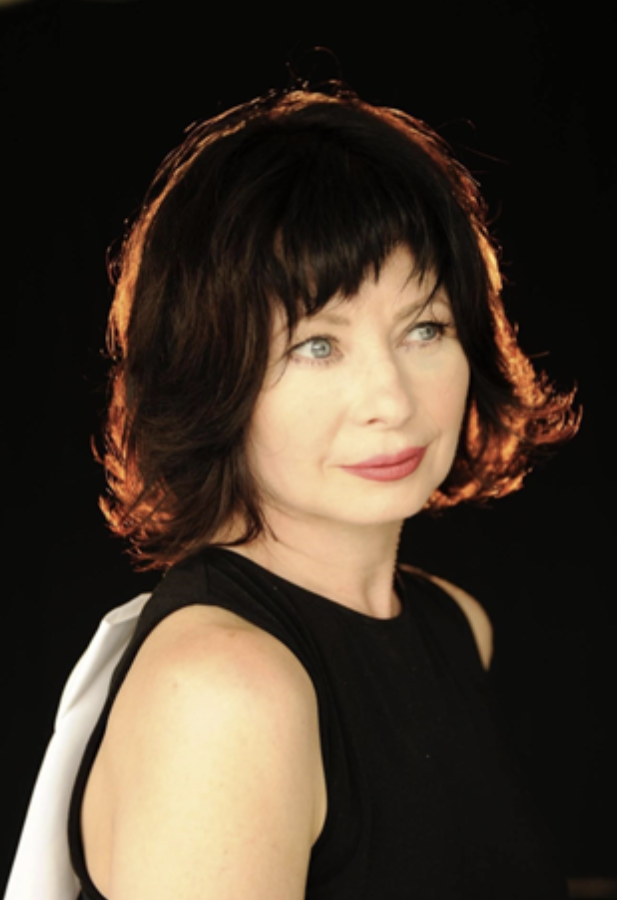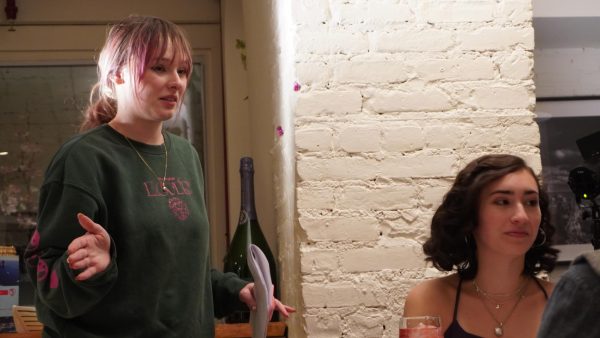Broadway Star Takes MMC’s Jazz Dance Piece to New Heights
Reading Time: 5 minutesMary Ann Lamb tells the dancers to move their bodies in an abrupt angular way. The fifteen dancers in the room all soar through the air weaving in and out of one another while consuming the space with their extravagant barrel jumps and turns. With fiery intensity, the dancers launch themselves through the space attacking each kick and jump with outstanding energy. Their strong and athletic movements are complemented by their boxy oversized blazers, vests, ties, and bowler hats. While the movement is characteristic of male dancers, all fifteen dancers are female and nail the strong movement.
Later on in the piece, two dancers’ eyes are locked on each other as the one dancer sits longing in a chair for the other. The remaining thirteen dancers lay on the ground surrounding the couple, eyes fixated on the intimate connection the two share. While this chair pas de deux occurs, dancers dressed in sexy black bras begin spinning in and around each other, using chairs as props. Additional intimate duets are interwoven showcasing this slower more sensual movement. Through partnering sequences where dancers maintain close body contact and relationship, the dancers create a sense of extreme femininity in the space that contrasts the earlier hyper-masculine scene.
Broadway legend, Mary Ann Lamb has come to bring her singular vision to a new piece. Her ten minute piece entitled “Jazz Man” features an all female identifying cast and tackles the prevalent conflict in the dance industry that is the dichotomy of masculinity and femininity. The piece draws inspiration from the life of world famous musician Billy Tipton who, after his death, was discovered by his family members to not be a male but rather a cisgender female. Lamb says, “I felt moved by Billy’s story. He was happy with his life and knew who he was. He celebrated that.” This concept got Lamb thinking about her relationship with masculinity and femininity in her own life.
The scene of the piece is set after this group of male musicians get off a tour bus. At this set time, only men were allowed to be in the bands as women were merely background singers or part of an all female group. The dancers start the piece dressed in the stereotypical male wardrobe and execute sharp movement. As the piece continues, the dancers transition to sultry and gooey movement and derobe to just a bra and pants to create a feminine feeling. The piece ends with the dancers back in their masculine clothes.
Lamb’s concept is to dismantle the societal stereotype that individuals need to be boxed into specific categories. “I don’t want it to seem like they are hiding. I want it to be a celebration of both this masculine and feminine energy,” says Lamb. This conflict of the masculine versus the feminine is not only apparent in the dance industry but has been a personal battle throughout Lamb’s whole career.
Each semester, Marymount brings in working professionals to set pieces on the dance majors to be performed during the Mainstage Showcases that occur in December and May. As a predominantly company-based program, Marymount has not featured an authentic jazz piece like this in over four years. Lamb’s coming and choreographing a more commercial dance piece is shaking the very fundamentals of the program and exciting many dance majors, especially those who are jazz concentrations. These dancers have felt deprived of jazz during the Mainstage Showcase and have been requesting a jazz piece for so long and are finally being granted this wish all thanks to Lamb. With Lamb’s caliber, the piece will surely bring MMC’s showcase to new heights.
Throughout her career, Lamb has been told by various directors and choreographers such as Jerome Robbins to “dance more like a girl.” As a sixty-three year old woman who has been in eleven Broadway shows and played over twenty-one roles in them, the Broadway legend has struggled with being told that she is not feminine enough all her life. When told to dance like a girl, Lamb would be overcome with frustration as she would think to herself, “What do you mean dance like a girl? I am a girl…I think I was born a tomboy so the thing that drew me to dance was two things: my amazing amount of energy being hyperactive, and I was very physical.”
Lamb grew up in Seattle, Washington with four older brothers and spent her early years battling undiagnosed dyslexia. “I have always been more tapped into that energy.” All her life, she has felt that she has resonated with masculine movement and struggled with dancing feminine as it just does not feel as organic in her body. She always wanted to perform the male roles or execute steps that were more commonly performed by men. Lamb remembers watching the “Crapshooters” Ballet in Guys and Dolls and wishing to do the giant powerful split jumps of the males rather than the delicate feminine steps she had to perform.
Lamb believes this masculine energy she was born with is the reason she was casted in the roles she was on Broadway. Describing herself as a “tough scrapper,” Lamb detailed some roles that she not only played but originated on Broadway such as Vibrata in A Funny Thing Happened on the Way to the Forum, June in Chicago, and Anybodys in West Side Story. She felt certain roles were easier to build a connection with than others.
As a choreographer, Lamb says that her influences come from real life situations or events that she encounters. Lamb’s piece is an image piece where the conflict is not onstage but rather is offstage as the conflict is society putting dancers and humans in boxes. She feels there is a serious issue in the dance industry regarding gender stereotypes that needs to be not only questioned but disassembled. Lamb believes this telling of performers to dance masculine or feminine goes to a deeper problem rooted in the beginning framework of dance.
When describing how this gender stereotyping in the dance industry was first brought to her attention, Lamb detailed how during certain musicals like Kiss Me Kate the males would come out doing impressive jumps and turns and the women would do small show girl choreography. “I want to break this outdated idea. Females can do everything males can do and vice versa,” Lamb says.
Even standing in the studio, Lamb commands the space with a fire in her eyes that is unlike most performers. She shares her years of valuable experience with the dancers in the forms of anecdotes and lessons sprinkled in amongst teaching her choreography. In rehearsals, she constantly tells the dancers their job is to “live their role the most honest they can.” In order to do this, she says that the dancers must pull themselves through the choreography and embrace both the masculine and feminine energy inside themselves. She has the dancers perform both masculine and feminine stereotypical movements for this reason.
“The most joy I have had in this piece is being in the studio with…the dancers. [The] girls are just so talented, and I can’t wait to show [them] off onstage” Lamb says.
Research:
https://www.stepsnyc.com/faculty/bio/Mary-Ann-Lamb/
https://www.broadwaydancecenter.com/faculty/mary-ann-lamb
Playbill Official Site:
https://www.playbill.com/person/mary-ann-lamb-vault-0000065161
IMDB:
https://www.imdb.com/name/nm0482992/
Broadway World “Broadway’s Backbone” Interview






